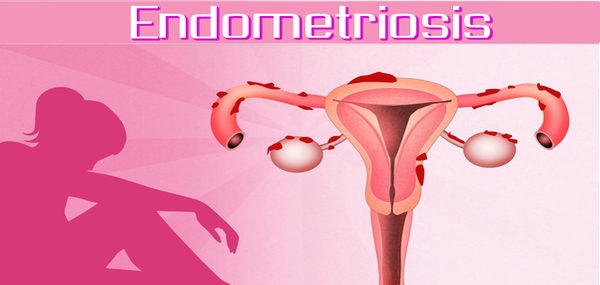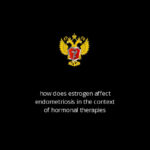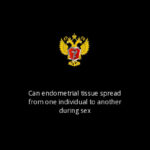Endometriosis Definition Symptoms and Treatment
Definition
What is endometriosis?
Endometriosis is a chronic estrogen-dependent disorder characterized by endometrial hyperplasia and overgrowth of endometrial cells outside of the uterus. The endometrium or endometrial lining is the tissue that lines the interior membrane of the uterus. In patients with endometriosis, the endometrial tissue grows in some areas outside of the uterus such as the ovaries, fallopian tubes, and the pelvic organs. Common symptoms of endometriosis may include severe discomfort and diffuse abdominal pains before and during menstruation.
Endometriosis is believed to affect about 6–10% of women worldwide. It commonly affects women between the ages of 25 and 40 (during their reproductive age).
Description
The endometrial cells line the internal part of the uterus, these cells are estrogen-dependent cells and thus they tend to grow especially during menstruation due to increased estrogen secretion. Normally, old endometrial cells (discarded endometrial cells) are expelled in the direction of menstrual flow through the cervical os during menstruation. This process prepares your body for conception by preserving and keeping a proper and clean site for the fertilized ova to implant. In case of no fertilization, the endometrium is cleared every month with menstruation, and the size of the endometrium is controlled or regulated by progesterone/estrogen hormone homeostasis.
Where endometriosis can grow?
Endometriosis is confirmed when “endometrial implants” are found in numerous amounts in the uterus and in other locations outside of the uterus.
Typical sites include:
- Ovaries
- Fallopian tubes
- External membrane of the uterus
- Outer surfaces of the bowel
- Other pelvic organs
- Other body tissues situated anywhere in the stomach
- Seldom endometriosis can be found in other sites within the female organism.

In all forms of endometriosis, the endometrial cells respond to the cyclical fluctuations in hormones, thus, during menstruation, the endometrial implants at distal (extraperitoneal) sites of endometriosis react the same way as those located within the uterus. And thus the growths outside of the uterus (endometrial implants) also bleed during menstruation. However, internal bleeding due to endometrial implants can lead to inflammation and may lead to adhesions and scar tissue formation (abnormal cellular growth that combine internal organs together). On the ovary, patients with endometriosis usually develop a cyst (a sac like formation) full of old blood (an ovarian endometrioma or an endometrial cyst).
Endometrial growths can be as small as 1 mm or more than 8 cm across.
An ovarian endometrioma (chocolate cyst) is a cyst arising from ectopic endometrial tissue. It contains thick dark-brown fluid. Endometriomas are usually adherent to surrounding tissues and organs, such as the peritoneum, fallopian tubes, and bowel.
Causes
What is the main cause of endometriosis?
The cause of endometriosis is unknown. However, scientists believe that during menstruation few endometrial implants flow backward into the abdomen through the fallopian tubes where they grow. An additional theory suggests that endometriosis can be a genetic process in particular families that have predisposing aspects (a genetic predisposition to endometriosis).
Symptoms
What are the symptoms of endometriosis?
The signs and symptoms of endometriosis are:
- Discomfort before and during menstruation
- Pain during, before and after menstruation
- Dyspareunia or painful sexual intercourse.
- Heavy and prolonged menstrual bleeding
- Exhaustion and vague feeling.
- Painful bowel movements and stomach cramps
- Pain with urination and painful defecation
- Large menstrual blood clots
- Trouble to get pregnant
Analysis
How to diagnose endometriosis?
Endometriosis is often only diagnosed by a doctor based on your symptoms and signs. However, true diagnosis can only be made laparoscopically. The condition can have mild, moderate, or even severe forms.
The diagnosis is confirmed with a small surgical procedure called laparoscopy. This procedure is carried out under narcosis. A laparoscope (a slim long tube with a light and a digital camera on the end) is inserted into a little cut made in the abdominal wall after inflating the abdominal cavity with carbon dioxide gas. The abdomen is inflated with CO2 to make it easier to see the internal organs with the laparoscope. By observing the abdominal cavity and abdominal organs with a laparoscope, your doctor can detect and see the place, extent and the size of the endometrial growths.
Endometriosis impairs fertility, women with endometriosis usually suffer of an impairment of implantation rates and endometrial receptivity, though endometriosis does not usually completely prevent conception. Impaired fertility (infertility) can be diagnosed by a fertility assessment.
Therapy
How to treat endometriosis?
There is absolutely no definitive cure for endometriosis. The goal of the treatment is to relieve the pain associated with the problem or to improve female fertility. Over-the-counter (OTC) pain relievers or discomfort medications are frequently prescribed to alleviate pain.
Common pain OTC relievers include:
- Acetaminophen (Tylenol)
- Nonsteroidal anti-inflammatory drugs (NSAIDs) such as ibuprofen (Motrin, Advil) or naproxen (Aleve, Naprosyn).
Your doctor will often start by prescribing a pain killer such as Ketanov or Citramon pills.
Contraceptive pills, Birth control pills, patches and vaginal rings are also used to deal with the disease as they help control the hormones responsible for endometriosis.
Common medications for endometriosis include: Megace (a chemical with antiandrogen activity similar to the female hormone progesterone), Lupron, and Danazol.
If required, your physician may recommend a laparoscopic surgery in addition to medications, to eliminate the endometrial implants from the abdomen and pelvis. Rarely, a hysterectomy (removal of the uterus) along with bilateral salpingo-oophorectomy (BSO or the removal of the ovaries) may be recommended to alleviate the main symptoms of endometriosis (cure to pelvic pain).
Verified by: Dr.Diab (September 16, 2018)
Citation: Dr.Diab. (September 16, 2018). Endometriosis Definition Symptoms and Treatment. Medcoi Journal of Medicine, 22(2). urn:medcoi:article1099.














There are no comments yet
Or use one of these social networks